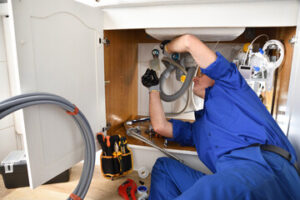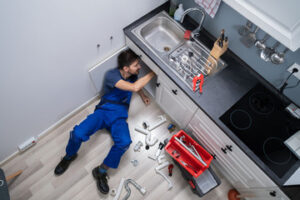If your bathtub is overflowing, or you have foul odors coming from the kitchen sink, it may be time to call in the professionals. But before you start pouring pipe-damaging chemicals down the drain, try these natural cleaners first.

Foul odors aren’t just unpleasant—they create the ideal environment for harmful microorganisms to grow and spread. Clogged drains can also cause costly plumbing repairs down the road. Reach out to Drain Cleaning Sarasota for expert assistance.
Hydro-jetting
Hydro jetting uses a powerful blast of water to clear blockages and remove debris from pipes. It’s an alternative to mechanical drain cleaners, such as plumbing snakes and augers. This drain cleaning technique is safer and more effective, as it doesn’t force debris deeper into the pipe. In addition, it provides a deep clean that can remove even the most stubborn clogs like tree roots and grease balls.
When the plumber inserts the nozzle into your drain, it’s important to make sure it has the right pressure for the job. This is why a drain inspection is always a good idea before this service is performed. This allows the plumber to determine the type of blockage and its severity, ensuring the nozzle is placed in the correct position to eliminate it. A camera will also help the plumber locate any damage to your plumbing and sewer system, allowing him or her to provide you with a complete diagnosis and the best solution.
This process is a great option for homeowners who suffer from recurrent clogged lines or backed-up sewers. The high-pressure water blasting action of this method is highly efficient, eliminating clogs and thoroughly cleaning the entire pipe. It is also safe for older pipes, unlike some mechanical drain cleaners. It can be used in conjunction with other drain cleaning services such as drain rodding or chemical treatments.
Using a specialized nozzle with different angles and sizes, the plumber directs the jet of water into the pipe to give it full scouring power along its insides. This effectively breaks up and flushes away sludge, scale, hair, grease, soap build-up, sand, and mineral deposits. This thorough cleaning of the pipe extends its lifespan, making it more resilient to clogs in the future.
This is a great preventative maintenance service that also helps curb the need for more expensive repair and replacement of the plumbing system. The high-pressure water flow also makes it more difficult for grime to settle and build up again. This way, you will only need to call a plumber for hydro jetting services once every few years or so.
High-pressure water jetting
Hydro jetting is the ideal method to use when dealing with drain or sewer line blockages. Unlike the snake or other traditional methods that only remove obstructions, high-pressure water jetting thoroughly cleans the entire pipe. This ensures that any residues are not left behind to clog the system again in the future. The process involves a technician inserting a nozzle into the blocked pipe and directing the jet stream at it. The force of the stream is dependent on the type of obstruction. For instance, a soft blockage like soap scum or grease may only require low pressure while dense debris or tree roots would necessitate a higher amount of pressure.
The nozzle is attached to the end of a heavy-duty hose that is powered by a motor to create a powerful stream of water. The nozzle can be adjusted to control the direction and flow of the water so that it is perfectly targeted at the blocked area. High-pressure water jetting can dislodge the most stubborn clogs without damaging the pipes. It is also very safe for the environment as it uses only water and does not introduce any chemicals into the pipe.
Another advantage of high-pressure water jetting is that it can reach places where other tools cannot. This is particularly useful in removing hard-to-reach obstructions such as tree roots. It can also be used to clear large blockages that have accumulated in the drain or sewer line, thereby preventing water from flowing freely. However, it is important to note that high-pressure water jetting should only be performed by a professional plumber who is familiar with the procedure.
There are several signs that indicate that your drains or sewer lines are in need of a thorough cleaning with a high-pressure water jetting machine. These include frequent clogging, a foul smell coming from the drains, and slow or backed up water. You can also check for any signs of damage to the drain or sewer line such as cracks, sagging, or exposed joints. Having these issues addressed promptly will help to prevent the need for more expensive repairs in the future.
Pipe cleaning
A clogged drain can be a nuisance and a health risk. If not resolved promptly, it can lead to water damage and sewage backups. In some cases, the clog can also affect the structural integrity of your home’s pipes. Clogged drains can also cause unpleasant odors, especially when food or grease is involved. The good news is that there are several ways to clean your drains and prevent clogs. Some of these techniques include chemical cleaning, a plumber’s snake, and regular drain flushing.
Chemical drain cleaners use different types of acids and solvents to eat away at organic buildup. This method can be used to remove hair, food, and grease from a drain. It is also useful for removing inorganic deposits like scale and rust. A plumbing professional can help you determine whether or not a chemical drain cleaner is right for your home.
Most liquid drain cleaners work by creating a chemical reaction inside the pipe. They contain sodium hydroxide that reacts with most organic material to produce heat and dissolve clogs. However, this reaction can also do damage to the pipes if the clog is too tough or compacted.
One alternative to liquid drain cleaners is a plumbing snake, which is a long piece of metal with a coiled wire at the end. This tool can break up and dislodge most blockages, including hair and other solid waste. If you are wary of using chemical drain cleaners, you can try a natural drain cleaner made with baking soda and vinegar.
Regular drain cleaning is important for maintaining functionality and preventing blockages. A simple way to do this is to pour a cup of bleach down each drain once a month. This will remove odors and keep the pipes healthy.
If you are looking for a long-term solution to clogged drains, you may want to consider getting your pipes hydrojetting. This is a safe and effective method for cleaning pipes. It uses a hose that is fed into your home’s drain system through a cleanout. A nozzle attached to the hose produces scalding blasts of hot, high-pressure water that can break through even the most stubborn clogs and make it hard for debris to return. The procedure is quick and can be done in one visit.
Camera inspection
A camera inspection for drain cleaning is a piece of professional high-grade plumbing equipment that helps plumbers find the source of blockages and other issues in a pipe. Its clear images help them locate the problem area, reducing guesswork and speeding up diagnosis. It also lets them guide the drain cleaning process more effectively, resulting in better and faster repair.
Aside from detecting clogs, the camera can also identify damaged sections of the pipes. This allows plumbers to repair them quickly and thoroughly, preventing future issues. It can also spot buried utility lines, ensuring that they’re not accidentally hit during excavation or drain cleaning.
Another advantage of a camera inspection is that it can pinpoint specific areas where a pipe is particularly clogged or full of roots. This can save a lot of time and effort because plumbers will only need to focus on these areas when using the drain cleaning machine. It can also save money as it prevents unnecessary repairs and prevents the need for multiple drain cleaning sessions.
The main reason for a Brooklyn residential or commercial property owner to consider getting a sewer line camera inspection is to discover the root cause of any problems with their plumbing and drain lines. Whether they’re experiencing slow drainage, gurgling sounds, or foul odors, discovering these issues early on can help them avoid costly repairs and keep their home or office safe.
In addition, the use of a drain camera can help them make informed decisions about future maintenance and repair needs. If the problem is due to a broken or collapsed line, a camera inspection can help them determine how severe it is and how much the repair costs might be.
Lastly, a camera inspection can also assist homeowners in identifying potential problems with their plumbing before they put their home on the market. Having a clear picture of their pipes can help them show prospective buyers exactly what they’re buying, which may increase the chances of a sale. Aside from that, it can also help them avoid any health department or building insurance issues down the road.

